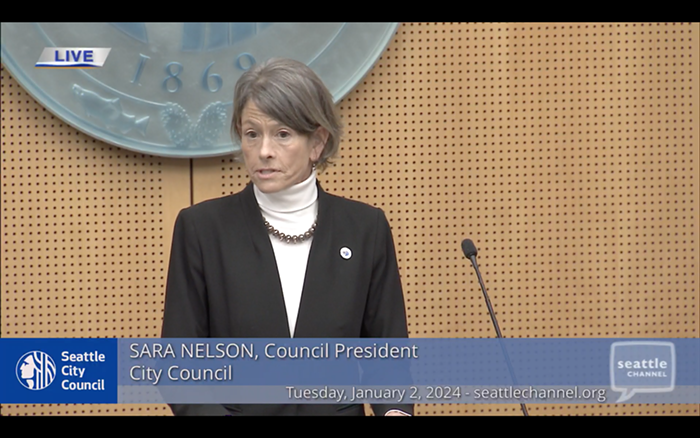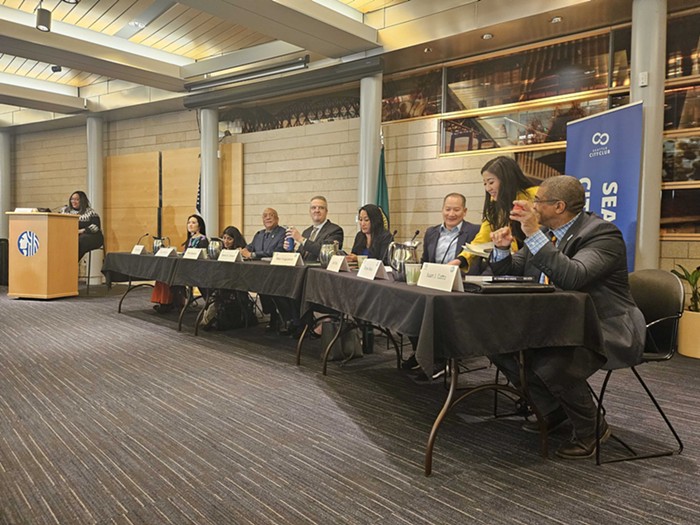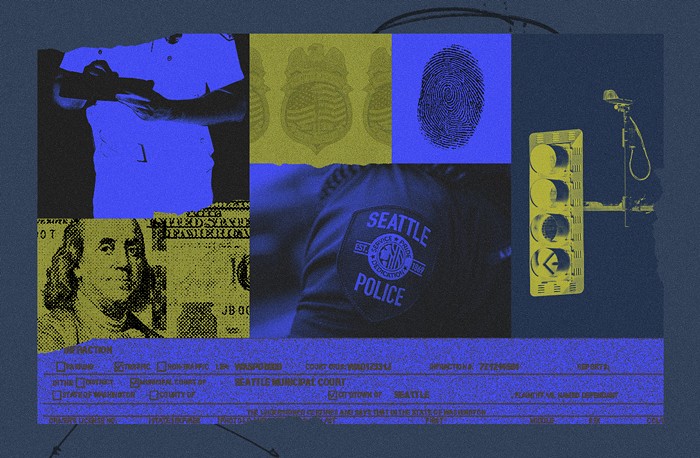The October 18 surveillance video taken from Joe's Mart in Belltown is undeniably disturbing: An undercover cop rushes into the convenience store located on Second Avenue and Pine Street to confront a black 17-year-old suspect who's in the store with a friend. The teenager promptly puts his hands in the air and appears to cooperate with the officer, who in turn kicks the teenager in the groin. Once the teenager falls to the ground, the officer delivers two more kicks to the teenager's chest and face.
"If I didn't know it was an undercover cop, I would've thought there was an assault being committed on a citizen," said Council Member Nick Licata, chair of the city council's Housing, Human Services, Health & Culture Committee, after reviewing the footage. "After I learned it was a plainclothes officer, it explains even less. The individual had his hands up in the air, which is a sign of surrender."
The teenage suspect has been charged with attempted robbery in connection with a botched undercover drug bust that occurred in the Belltown area that night. Still, Seattle Police Department (SPD) command staff agree that protocol wasn't followed during the arrest. "Based on what I saw, my professional discernment told me this may be a case where use of force may have been excessive," Deputy Chief Clark Kimerer said of the video.
Far from being abnormal, this incident is the latest in a line of violent clashes between Seattle police officers and minority suspects—clashes that have included suspects being stomped in the head, punched in the face, and fatally shot. And despite civic outrage, public protests, and departmental shuffling within SPD, violence committed by the SPD continues to occur with regularity. Many city officials and organizations—including the American Civil Liberties Union of Washington (ACLU)—believe SPD is incapable of spearheading its own reform. The ACLU is now calling on the U.S. Department of Justice (DOJ) to step in and reform the department's out-of-control policing practices.
"These repeated incidents over the last 18 months, which have continued unchecked and without forceful intervention by the Seattle Police Department, the mayor, or Seattle's other elected officials, leads the ACLU to call on the U.S. Department of Justice to investigate whether there is a pattern and practice of civil rights violations by the Seattle Police Department in violation of the constitution and federal law," wrote ACLU executive director Kathleen Taylor in a statement last week. The ACLU won't comment further on its request until it is submitted to the DOJ later this week. The DOJ would most likely review SPD's practices, target how and where violations were occurring in police policy, and obtain a court order to eliminate the pattern or practice that causes the violations. Once a judge approved the DOJ's order, it would become legally binding.
The pattern of violence against minority suspects stems from last April, when Detective Shandy Cobane was caught on tape telling a Latino suspect lying prone on the ground that he was going to "beat the fucking Mexican piss" out of him before stomping on the suspect's head; the suspect turned out to be innocent. (Later that month, Cobane allegedly choked another suspect in Belltown, according to a complaint filed with the Office of Professional Accountability [OPA], which investigates police misconduct.) In June, Officer Ian Walsh punched a 17-year-old black girl in the face during a jaywalking stop. In August, Officer Ian Birk fatally shot John T. Williams, a Native American woodcarver, with four shots in his left side, even though Williams's carving knife was reportedly closed at the time of the incident.
Excluding the punching of the jaywalker and Williams's death, SPD didn't acknowledge these incidents until local media outlets came calling for comment. "We can't have that for a functioning city," says Licata. "It makes city government look like we don't know what we're doing."
SPD's response to the recent incident in the convenience store follows this same reactionary pattern. The King County Prosecutor's Office says detectives were in possession of the tape on October 27—three and a half weeks before the video was obtained by KIRO. News of the video's existence was leaked to The Stranger on November 18. SPD won't comment on who saw the video, when they saw it, or why the OPA still hadn't been alerted to its existence a month after the incident occurred. "Those questions can't be addressed," says police spokesman Sergeant Sean Whitcomb, citing an "ongoing internal investigation." (Incidentally, a cell-phone video taken that night and aired by KOMO appears to show the same undercover officer shoving a witness as he tries to film the police activity. SPD says that this footage has been added to the internal investigation.)
At a press conference on November 19, Deputy Chief Kimerer confirmed that the officers in possession of the tape didn't notify their superiors or send it to internal investigators, as SPD protocol dictates. Instead, they sat on it until two deputy chiefs requested the video acting on a tip from KIRO television. SPD has since ordered a misconduct investigation and taken the officer shown in the video assaulting the teenager off duty.
"The policies are there; they just aren't being followed," says Licata. "There's not the paper trail there should be. There should be a use of force form completed any time an officer uses physical force on a suspect or arrestee, but in many cases, it's not completed. I'm not getting the sense that there is much stringent supervision over line officers in situations like this."
Seattle City Council member Bruce Harrell agrees. "I assume that when detectives review video footage like that, they have an obligation to immediately report it to their superiors, and perhaps to the Office of Professional Accountability," he says. "I would like to know why that wasn't done. I think, quite frankly, we deserve a very clear answer, because it raises the question about what video evidence or other evidence is sitting around confidentially. This one came to light because Deputy Chief Kimerer asked for it and he knew what to ask for. What if he didn't know what to ask for?"
Harrell also points out that several high-profile cases of apparent police misconduct in Seattle have come to light only because they were caught on video. In the infamous "Mexican piss" case this spring, a cameraman caught the beating on tape, but police sat on that footage for at least a week and didn't make any comment or begin an investigation until it was aired on Q13.
"These questionable cases of misconduct by the police officers is not only wrong on a legal basis, but it costs the taxpayers millions of dollars," Harrell says. He says he believes the SPD's recent shooting of Williams "is going to be very costly."
Despite the trend of controversial cases, Council Member Tim Burgess seems certain that the SPD's internal investigation will be sufficient. "I have full confidence in Chief [John] Diaz and the Office of Professional Accountability to diligently review the facts and reach an appropriate conclusion about the officer's conduct and the department's handling of the video," he said in a statement.
Harrell thinks all Seattle officers should wear body cameras that record incidents like these so the city has footage even when a random camera doesn't catch misconduct. And when police do get footage, body-camera records would help ensure the footage doesn't disappear. He says the city is set to replace 276 cameras in police cars (at a cost of $2.2 million) within the next three years, and the city should use that money instead to outfit all patrol officers in the city with the less-expensive body cameras.
"We do have the attention of the public by asking some hard questions and forcing SPD to respond to them publicly," says Licata. "I think we can use our stature to persuade SPD command staff to step up to the challenge of demanding discipline in their department." ![]()


















